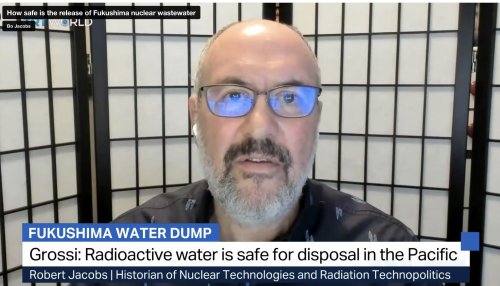How safe is the release of Fukushima nuclear wastewater?
The IAEA, and the governments of Japan and South Korea have declared the releases safe. People all around the Pacific Ocean are protesting the releases however.
Where does the nuclear wastewater come from? What is in it?
Because the melted nuclear cores (corium) of reactors 1, 2 & 3 at Fukushima Dai'ichi are somewhere underneath the three reactor buildings, having melted out, workers at TEPCO have been pouring cold water on the corium since the meltdowns to cool the corium. This is both to prevent spontaneous fissioning, and also to carry heat away from the mess so that it may eventually be removed sometime later in this century (the melted core of Chernobyl is still underneath the reactor, almost 40 years later, and still has not schedule for removal). All of the water used to cool the corium is then pumped into holding tanks on the grounds of the Fukushima site. Also, groundwater flows through the basements that hold the corium, and that adds to the water being pumped out.
Since this water has been in contact with corium and the mess surrounding it, the water has picked up a range of radionuclides. The different particles decay at different rates. Also, some particles are large enough to be filtered out from the water. Some things, like tritium, cannot be removed from water since it is a form of hydrogen. TEPCO's own accounting for the radionuclides remaining in the water differs tank by tank.
The government of Japan wants to release this water from the tanks, primarily because there is more water that needs to be put into the tanks everyday. This will continue for decades as the corium is cooled, but even after that, because of the flow of groundwater through the basements. The need to pump out and hold water will be ongoing. The strategy of dumping the current contents into the Pacific is compelled by the need to free up space to fill with the water that continues to take on radionuclides from the corium.
Because the dumping of the tanks is a political negative for the government of Japan, a pipeline is being built so that the water can simply be dumped via underground pipe, and the theatrics of dumping the tanks into the ocean can be avoided in the future. A political solution to a problem with few mechanical solutions.
What else can be done? As Ken Buesseler of Woods Hole Oceanographic Institution has said, the water could be moved to much larger tanks and held for up to a century, which would facilitate some further decay of the radioactivity of particles before they are released. However, this would be seen as a political negative as it would fill parts of Japan up with large holding tanks for a century, and remind everyone about the problem.
What are the risks to health from the waste? Some who explain away the risks will point to the low levels of externally measurable radiation in the water, and assert that as it is diluted in the ocean, the levels or radiation will be negligible. However, the risks do not come from external exposures to the radiation, the risks come from internalizing individual radioactive particles. The number of these particles remains the same, no mater how diluted they are. Internalizing one of them posses risk to living creatures. This includes fish and plants. As the apex predators, humans are consume ocean fish and plants and thus, for long-lived particles, the risk will endure long past the event of dumping the water.
Here is a short interview I had on TRT World with Katie Pilbeam on 7 July 2023 about these issues:
